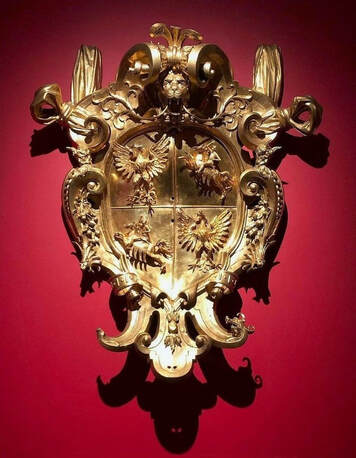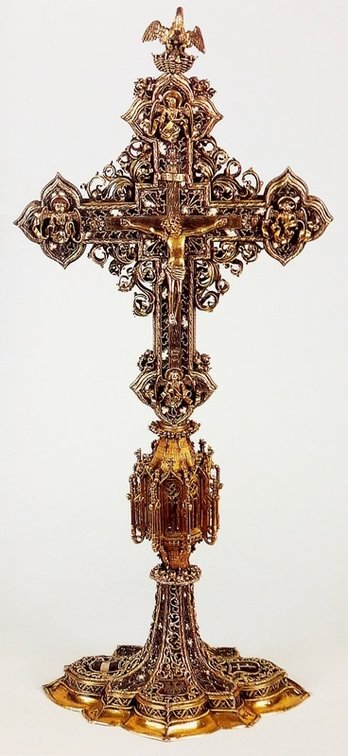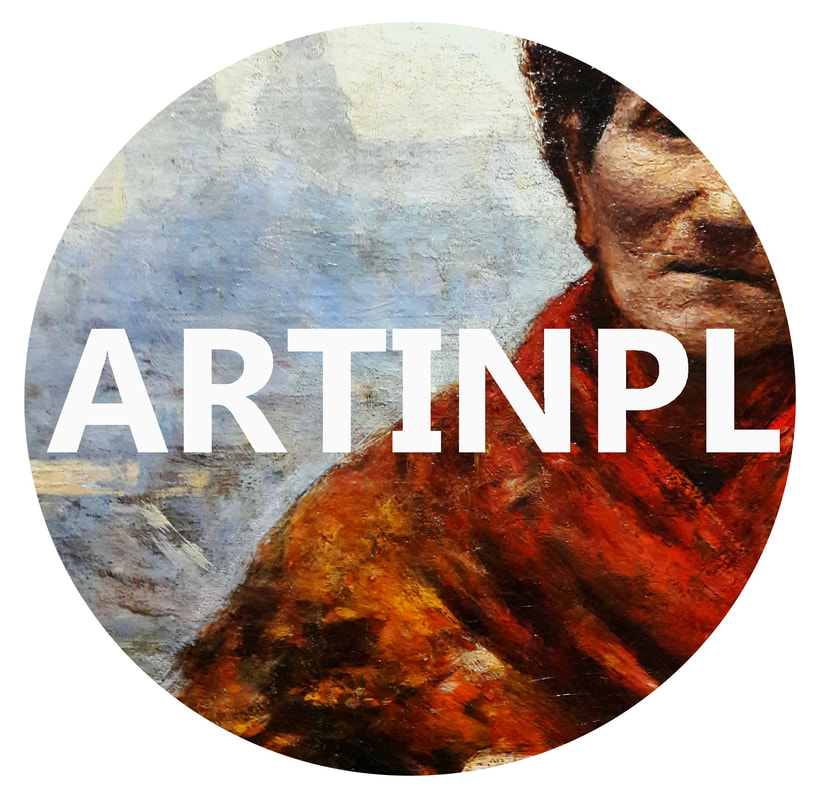|
A work of high artistic merit is a trophy from the Great War with the Teutonic Order between 1409-1411. It was made for the Commander of Elbląg, Thile Dagister von Lorich. The diptych, a portable altar with relics, was taken by the brothers from the Elbląg monastery to the battle of Grunwald, where it fell into the hands of the Poles on July 15, 1410. Full-figured representation of the Crucifixion on the left panel is accompanied with the figures in two rows on the right panel depicting adoration of the Virgin and Child by the founder, recommended by Saints Barbara, Catherine, Margaret, Apostles Peter and Paul and Saint Dorothy. A gothic minuscule in the South German dialect on the outer side of the reliquary informs on the person of the founder, who was also depicted of the left panel as a donor before the Virgin. The outer side of the right panel depicts Man of Sorrows amid arma christi. The work was most probably created by a goldsmith William from Elbląg, who was frequently mentioned in the books of the Malbork Castle between 1399-1409.
Reliquary diptych of Thile von Lorich by Anonymous from Elbląg, 1388, Polish Army Museum in Warsaw.
See more pictures of Medieval Pomerania on Pinterest - Artinpl and Artinplhub
The second reception stairway, the Senators' Staircase, of the Wawel Castle was constructed between 1599 and 1602 by Giovanni Trevano and Ambrogio Meazzi in the north-west corner of the castle. It is the first such modern construction in Poland facilitating the communication between the floors of the residence and located in the interior space of the edifice. Marble stairs do not run steeply, as it is in the Renaissance Deputies' Staircase, but break up regularly in the middle floors with comfortable podests. Early baroque portals of the saircase with auricular elements designed by Trevano were executed in greenish Carpathian sandstone by Meazzi. The Summary of the Royal spendings by the Kraków's supevisor Franciszek Rylski of Ostoja coat of arms from 1599 and 1600 in the Central Archives of Historical Records in Warsaw (I 299), records a spending of fl. 2991 gr. 15 den. 12 "for demolition of the old stairs and construction of the new one, for Italians and different materials" and salaries of "Jan Treurer (Giovanni Trevano), mason ad r[ation]em fl. 1300 datum fl. 1250" and "Ambrosio Meaczi (Ambrogio Meazzi) to inlay the stairs and doors ad r[ation]em fl. 500 datum fl. 300".
Senators' Staircase of the Wawel Castle, constructed between 1599 and 1602 by Giovanni Trevano and Ambrogio Meazzi.
Bronze cartouche with coat of arms of the Polish-Lithuanian Commonwealth without the Vasa emblem (missing) from the Wawel Castle by Anonymous from Poland, 1604, Czartoryski Museum. One of the cartouches from the overdoor in the northern wing of the castle leading to the Senators' Staircase.
See more pictures of Wawel Royal Castle during the Vasas on Pinterest - Artinpl and Artinplhub
Reliquary cross, so-called smaller, one of the most exquisite examples of Kraków's late gothic goldsmithery, was founded by Cardinal Frederick Jagiellon and executed by Kraków's goldsmith after 1493. The cross, together with so-called bigger cross was ceded to the Gniezno Cathedral in 1503 as a testament bequest of the cardinal, who was a bishop of Kraków and archbishop of Gniezno. During the World War II, it was confiscated by the Nazis and transported to Germany and restituted by the church authorities in 1958.
The piece was adorned with a pelican feeding its young with its own blood, a Christian symbol of selfsacrifice at the top, floral motifs and enammeled coat of arms of the cardinal in lower parts. The cross of gilt silver and enamel, cast, repoussed and engraved and measuring 53.4 × 2.7 × 20.1 cm (21 × 1.1 × 7.9 in) is on display in the Archdiocesan Museum in Gniezno (inventory number 273).
Reliquary cross of Cardinal Frederick Jagiellon by Kraków's goldsmith, after 1493, Archdiocesan Museum in Gniezno.
See more pictures of Medieval Poland on Pinterest - Artinpl and Artinplhub
|
Artinpl is individual, educational project to share knowledge about works of art nowadays and in the past in Poland.
© Marcin Latka Categories
All
Archives
April 2023
|






